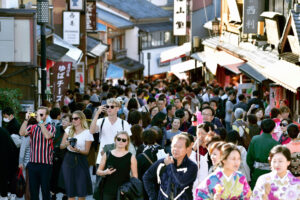No products in the cart.
Navigating Japan’s 89% Over Tourism Surge: Mount Fuji’s Hidden View and Kyoto’s Local Upset
Introduction:
Since Japan’s reopening post-COVID, a surge in tourism has posed challenges, including over tourism in popular destinations like Kyoto and the obstruction of Mount Fuji’s iconic view in Fujikawaguchiko. As crowds flood these areas, locals grapple with the impact on their communities and cherished landmarks. The influx of visitors not only strains local infrastructure but also disrupts the daily lives of residents, leading to increased noise pollution, traffic congestion, and wear and tear on historical sites. Additionally, the surge in tourism has prompted concerns about environmental sustainability and conservation efforts, as delicate ecosystems and natural landscapes face unprecedented pressure from the influx of visitors. Balancing the economic benefits of tourism with the need to protect cultural heritage and natural resources remains a pressing issue for communities across Japan.
Mount Fuji’s Hidden View:
In Fujikawaguchiko town, Japanese officials are implementing a bold strategy to tackle over tourism by installing a 2.5-meter-high mesh net that blocks views of Mount Fuji from a popular photo spot. This measure is a response to issues like littering, traffic violations, and disruptive behavior by some tourists, aiming to protect the area. The net highlights the growing conflict between preserving cultural landmarks and managing the large number of visitors drawn to scenic views. Although controversial, the installation is seen as a necessary step to safeguard Mount Fuji’s natural beauty and the surrounding environment. It emphasizes the need for responsible tourism and sustainable solutions to manage the impact of over tourism on Japan’s beloved destinations.

Shibuya’s Tourist Overload:
In Tokyo’s Shibuya district, the surge in tourist numbers has led to significant congestion and disruption of local life. Once a symbol of Japanese culture, Shibuya’s lively streets are now overwhelmed by crowds, straining the area’s ability to retain its unique charm. Residents are growing increasingly frustrated with the noise, litter, and disturbances caused by the influx of visitors, leading to demands for more sustainable tourism practices and better management of tourist traffic. While efforts are being made to balance tourism with the preservation of the local environment and lifestyle, Shibuya’s popularity continues to pose ongoing challenges as it remains a major draw for those wanting to experience Tokyo’s vibrant atmosphere.
The Impact of Over tourism:
The increase in tourism, while economically advantageous for Japan, has sparked worries about its long-term sustainability and effects on local communities. Overcrowding not only affects the quality of the tourist experience but also jeopardizes the preservation of cultural heritage sites and natural landscapes. With rising visitor numbers, there is an urgent need for thorough planning and management strategies to prevent local infrastructure from being overwhelmed and to protect Japan’s renowned landmarks. Implementing sustainable tourism practices, involving local communities, and enforcing stricter regulations are crucial to balancing the promotion of tourism with the protection of Japan’s cultural and environmental assets for future generations.
Seeking Solutions:
Investing in alternative tourist attractions and encouraging travel during off-peak seasons can help spread visitor traffic more evenly throughout the year, alleviating the strain on popular destinations during peak times. Engaging with the local community to gather input and involve residents in tourism planning can foster a sense of ownership and accountability regarding tourism management. Additionally, utilizing technology like mobile apps and real-time data analytics can improve the monitoring of tourist flows, enabling timely adjustments to reduce congestion and enhance visitor experiences. By adopting a comprehensive and cooperative strategy, Japan can achieve a balance between tourism growth and sustainability, ensuring that its cultural heritage and natural landscapes remain accessible and well-preserved for future generations.
Promoting Responsible Tourism:
Additionally, launching educational campaigns across multiple platforms, including signage, brochures, and digital media, can increase tourists’ awareness of the need to preserve Japan’s cultural and natural heritage. By emphasizing the value of responsible tourism and showcasing how visitors can positively impact local communities, these campaigns can encourage travelers to behave thoughtfully. Collaborating with tour operators and travel agencies to incorporate sustainability into tour packages and itineraries can also promote responsible travel behaviors. By cultivating a culture of mindful tourism, Japan can protect its cultural treasures and natural landscapes for future generations to experience and enjoy.
Conclusion:
Engaging in open dialogue with various stakeholders—such as local communities, businesses, and tourism organizations—is crucial for creating sustainable tourism strategies that benefit all parties. By emphasizing community involvement and taking into account the needs and viewpoints of residents, policymakers can implement solutions that alleviate the negative effects of over tourism while enhancing economic benefits and preserving cultural heritage. Additionally, encouraging visits to alternative destinations and promoting travel during off-peak times can help distribute tourist traffic more evenly throughout the year, easing the strain on popular locations and supporting a more sustainable tourism model. By adopting a comprehensive approach to tourism management, Japan can safeguard its cultural legacy, improve visitor experiences, and ensure the long-term viability of its tourism sector.









